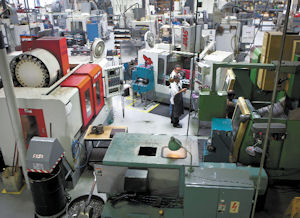Local manufacturers are using a “lean” system to help cut the unnecessary fat in their operations, leading to faster throughput and higher profitability. Roberts Tool Co. Inc., Superior Thread Rolling Co. and International Laser Group are just a few manufacturers in the San Fernando Valley region that have experienced the benefits of “lean manufacturing,” an efficiency model in the industry that aims to maximize customer value while minimizing wasted time and resources. Lean manufacturing has its roots in the Toyota Production System, which the auto maker formed in the 1930s and 1940s to fine-tune the manufacturing assembly model of Henry Ford, according to the Lean Enterprise Institute. Toyota’s system aimed at improving continuity of production flow while keeping costs low and product variety high. • Beginnings: Roots linked back to the Toyota Production System in the 1930s, which attempted to provide more process flow continuity and product variety to Henry Ford’s assembly model. Process further defined by authors James P. Womack, Daniel Roos and Daniel T. Jones in the 1990s. • Term Coined: In 1980s by a research team headed by Womack at MIT’s International Motor Vehicle Program • Goal: Maximize customer value while minimizing waste Five-Step Process: Understand value as defined by the customer Define the value stream for the organization Establish continuous flow within the organization Maintain the flow through the use of a pull system Pursue perfection through continuous improvement Sources: Lean International Institute, California Manufacturing Technology Consulting The “lean” term wasn’t used to describe the process until the late 1980s by a research team headed by Jim Womack at MIT’s International Motor Vehicle Program. The concept was further defined in the 1990s in books by Womack and others. Since then, more manufacturing companies have been adopting the method, especially as there are no other major efficiency models in industry that compete with it, said John Anderson, a consulting services director for California Manufacturing Technology Consulting based in Torrance. Chatsworth-based Roberts Tool Co. started using lean manufacturing in 2000 after one of its largest customers encouraged the precision machine shop’s owners to join the bandwagon. “Everyone was going in that direction,” said BJ Schramm, president of Roberts Tool Co. “It’s either get on the train or watch the train go off into the sunset and you’re not on it.” The company’s owners brought in professional lean experts and started implementing cellular manufacturing, which is one of lean’s many components. Through cellular manufacturing, Roberts Tool Company set up groups of machines that allowed parts to run from one machine to the next continuously. “You eliminate quiet time, or idle time, between machines,” said Schramm, who added that the product batches before had to wait days until the next machine was ready. “You can quote a part for two to four weeks lead time instead of 12 to 16 weeks.” Other concepts Roberts Tool Co. has also implemented other lean manufacturing concepts. The company uses software that tracks the orders from beginning to end. The company also uses lean’s “5s” concept, which is a system for reducing clutter in the workplace. Schramm said he believes the methods are adding to the company’s profitability. When Roberts Tool Company started with lean manufacturing in 2000, it had revenues of $5 million. When Schramm joined the company in 2008, its revenues were up to $17 million. For 2011, the company is projecting about $30 million in revenues. Superior Thread Rolling Co., an Arleta-based firm that manufactures aerospace fasteners, also implemented lean manufacturing. However, the company’s owner said getting the right flow is no easy task. “We started our thread roll cells back around 2000 and went through three machine moves (and floor plans),” said Tom Mundy, the company’s president. While Mundy said he now has a good flow moving through his factory, it takes constant work to remain efficient. “Lean is a journey that never ends,” he said. Anderson, of California Manufacturing Technology Consulting, agreed. “It’s a continuous improvement initiative, so when you reach your current best practices, then you look to improve for better practices,” Anderson said. “The reason is all of the manufacturers globally are getting more and more competitive and labor is a big portion of it.” Focus on supply chain Superior Thread Rolling’s more recent lean focus has been on speeding up its supply chain performance, which requires strengthening relationships with suppliers and making sure communication is clear. Other goals for this year also include improving on-time delivery, lowering costs from unusable parts that have errors and increasing sales levels per sales employee. Anderson said successful implementation of lean manufacturing starts at the top. “The commitment of management needs to be visible and there needs to be a communication plan about why an initiative is being undertaken,” Anderson said. “If you don’t have a good change management system in place and continually reinforce the change, you backslide to where you started.” Anderson said it is also important to make sure all employees have the proper lean training. That is also the advice of International Laser Group, or ILG, a Woodland Hills-based manufacturer of imaging supplies and toner cartridges that uses the lean system. “You should come through with consistent high-quality products if everybody’s on the same page with what is expected and how to do it,” said Joe Shulman, the company’s senior vice president and director of operations.
